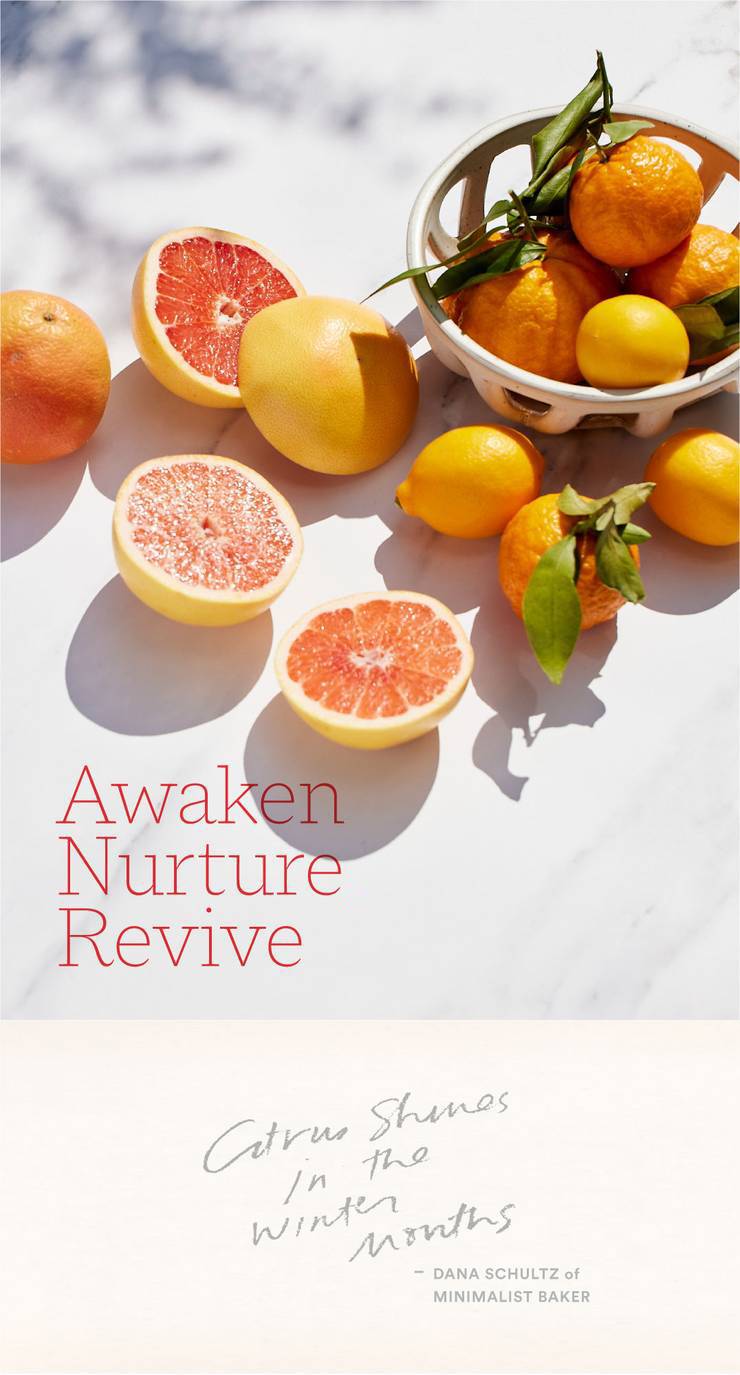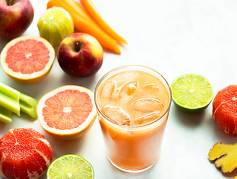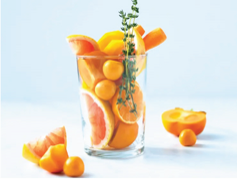Articles
Embrace
Winter Wellness
AWAKEN
The bright, tangy, and sweet flavors of citrus fruits are just what the body needs this time of year. This sun-colored produce can also help boost your mood until spring by fueling you from the inside out.
Grapefruits, oranges, mandarins, lemons, and limes are all at their peak this month. These fruits deliver a high dose of vitamin C, which can help support the immune system. But that’s not all.
Citrus also contains B vitamins, potassium, magnesium, and copper.[1] In addition, they are rich in plant compounds that work synergistically to provide antioxidant, anti-inflammatory, anti-cancer, anti-microbial, and anti-allergy properties along with both cardiovascular protection and neuroprotective effects.
Citrus goes great in salads, dressings, juices, and smoothies, or makes a delicious snack. Try some slices of orange or clementine with a few squares of dark chocolate as a simple dessert.
With so many varieties to choose from, here are a few of our favorites.
GRAPEFRUIT
This fruit has a thick rind with a tart, bitter flavor. They come in several varieties including pink, ruby red, and white. Many people prefer grapefruit juice to orange when making mimosas.
In juice, pair with apple, orange, pineapple, or beet.
BLOOD ORANGE
Winter is a great time to indulge in blood oranges-as-their-season runs from November to March. This smaller variety is known for its sweet flavor and juicy red flesh. In juice, pair with beets, carrots, or grapefruit.
MANDARIN
This smaller orange is the original and the ancestor to all other types of oranges. Mandarins look like little pumpkins and have a thin skin, making them easy to peel. They are sweet and juicy. In juice, pair with lemon, pomegranate, or mint.
CLEMENTINE
Clementines are even smaller than tangerines, but they are still a type of mandarin orange. They are seedless and also have a light, sweet flavor. You may see them in stores sold as “sweeties” or “cuties.” In juice, pair with cranberry, cherry, or carrot.
SATSUMA
In the mandarin family, satsumas are the smallest variety. They originated in Japan, and like other mandarins they are easy to peel, sweet, and produce a high yield of liquid. In juice, pair with lime, orange, or ginger.
TANGERINE
Tangerines are a type of mandarin orange. They are slightly smaller and a little sweeter than oranges, but still exhibit bright orange skin and are also easier to peel than an orange. In juice, pair with carrot, greens, or cantaloupe.
TANGELO
This cross between a tangerine and grapefruit has a flavor that’s both sweet and sour. Also known as honeybell, they are high in vitamin C, flavonoids, potassium, and folate. In juice, pair with lemon, orange, or ginger.
NAVEL ORANGES
Oranges are one of the top five fruits purchased in the U.S.[2] This popular variety of orange is seedless and great for adding more sweetness to your juices and smoothies. In juice, pair with greens, carrot, fennel, or beet.
OTHER WAYS TO AWAKEN YOUR BODY THIS WINTER INCLUDE
Drink more water, especially first thing in the morning. Drinking a glass or more of water can help jump-start your hydration for the day, which can impact your mental performance. One small 2019 study found an association with drinking water to help alleviate fatigue and improve short-term memory and attention.[3]
Try some “good” stress on the body by taking a cold shower, cold plunge, or splashing your face with cold water. It might sound like the opposite of what you want to do when temps are low, but cold bathing is a common custom in many countries throughout the world. Just 1 to 5 minutes of cold water exposure in a bath or shower can increase your energy by triggering a release of epinephrine (adrenaline) and norepinephrine (noradrenaline). These neurochemicals, sometimes known as stress hormones, are responsible for that feeling of alertness and “get-up-and-go” energy in the brain and body. Cold exposure also produces a prolonged release of dopamine, which can elevate your mood and enhance focus.
Get moving. While colder weather can make you want to linger in bed, one of the best ways to feel more alert is to move your body as part of your morning routine. It doesn’t have to be a long gym session, but going for a 15-minute walk outside, doing some yoga, or finding another movement practice you like will help get your blood flowing.
NURTURE
February is a great time to indulge in comforting activities. It’s a time to relax, enjoy cups of tea, and try out new recipes.
One of the most nourishing beverages this season is warm tea. Drinking tea is another way to consume plant compounds called polyphenols, which are antioxidants also found in fruit and vegetable juices.
Not only is drinking tea relaxing, but it also can help with cognitive function. One study found a positive correlation to tea drinking and brain structure, suggesting a protective effect on age-related decline.[4]
You can find both caffeinated and herbal teas. Caffeinated teas come in different colors and are derived from the Camellia sinensis plant, such as black, green, oolong, and white teas. The colors come from how long the leaves of the plant oxidize. The longer they oxidize, the darker they become. In terms of caffeine, black and oolong have the most, while green and white have less.[5]
CAFFEINE PER 8-FLUID OUNCES
Black Tea: 64 to 112 mg
Oolong Tea: 29 to 53 mg
Green Tea: 64 to 112 mg
White Tea: 29 to 53 mg
JUICE + TEAS
Adding some warm tea to a juice is a great way to consume more plants and polyphenols in the wintertime. Try white or green tea with green juice, or a black tea mixed with cherry or pomegranate juice.
Many natural herbal teas are caffeine-free. They come from a variety of different plants and have different health benefits. You can find these teas bagged at a grocery or health food store, or sold as loose herbs either online or at a specialty store. You can mix them in juices or smoothies, warm or cold.
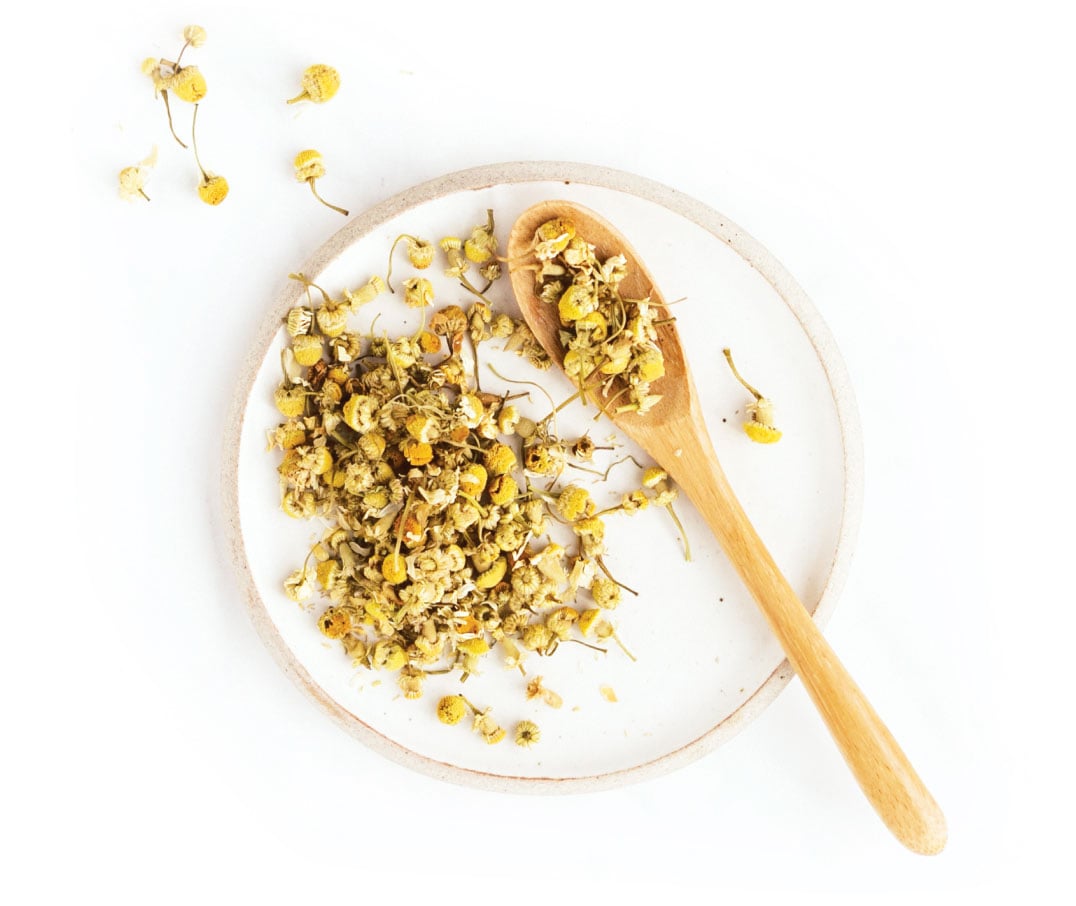
CHAMOMILE
This plant comes from the Asteraceae, or daisy, family and has been used traditionally as a medicinal plant with healing properties. It contains a variety of antioxidants including flavonoids, terpenes, and polyphenols.[6] This tea is great to drink before bed to help induce better sleep, and is often used to ease an upset stomach, gas, diarrhea, insomnia, and anxiety.[7] Pair with apple or pear-based juices, such as apple, lemon, and ginger juice.
CHAMOMILE + CITRUS SIP
Lemon combines with carrots, fennel, apple, and chamomile tea for a nurturing drink that is sure to help you feel calm and cozy in winter months and beyond. Think of it like a winter lemonade.
Ingredients
(Makes about 20 ounces of tea and juice)
- 8 ounces of chamomile tea
- 1 lemon
- 1 medium fennel bulb
- 1 apple
- 2 yellow carrots
Directions
- 1. Boil water and let chamomile tea steep for 5 minutes.
- 2. While tea is steeping, wash your juice ingredients.
- 3. Cut all ingredients into the appropriate size for the juicer.
- 4. Juice in the order given.
- 5. Combine tea with juice and enjoy!
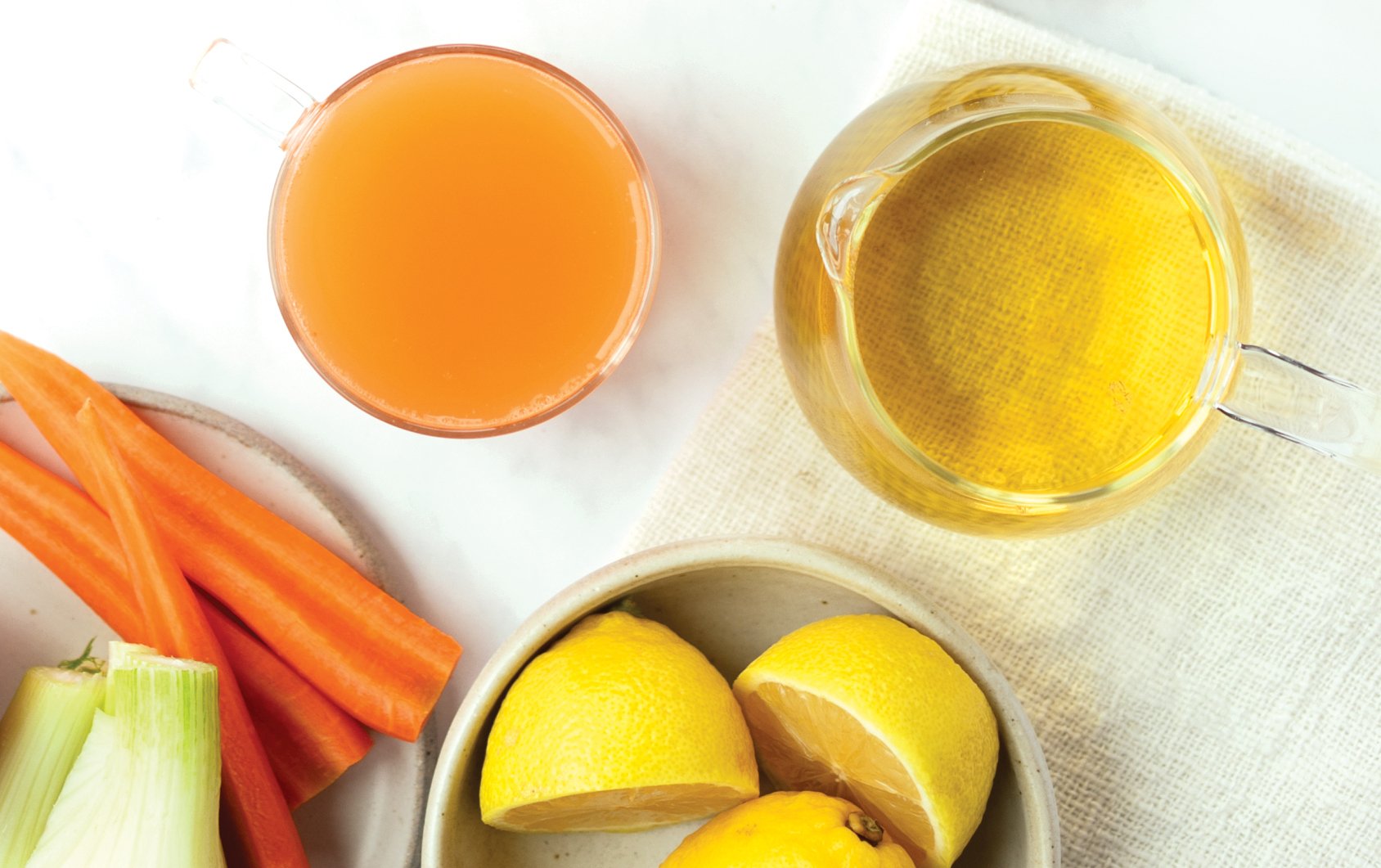
OTHER JUICE + TEA PAIRINGS TO TRY
CCF
Cumin, coriander, and fennel seeds make CCF tea, which in Ayurveda is known to aid in the absorption of nutrients, calm the gut in general, and help stimulate the lymphatic system. You can find this tea premixed or make it yourself by mixing ½ teaspoon of cumin, coriander, and fennel seeds with about 4 cups of hot water. Allow the tea to simmer for 20 minutes, then strain out the seeds, and enjoy. Pair with a fennel juice, such as cucumber, fennel, and ginger juice.
GINGER
While ginger adds a bit of spice to juices, it’s also a great root for making tea. It’s perfect to warm you up during colder temps or help with tummy troubles. Research suggests that ginger can help reduce post-chemotherapy nausea in those with cancer.[8] Pair with citrus or carrot juice, such as apple, carrot, and beet juice.
HIBISCUS
This red flower is cultivated throughout tropical and subtropical regions, including Egypt, Mexico, and China. It contains cyanidin, a naturally occurring pigment also found in cranberries and raspberries. Studies have found that hibiscus can help maintain healthy cholesterol levels.[9] Pair with a tropical juice, such as cranberry, pineapple, and lime juice.
PEPPERMINT
Another great tea to support digestion is peppermint, a hybrid of water mint and spearmint. It contains menthol, which is known to help soothe an upset stomach or help with motion sickness. Pair with a green juice, such as cucumber, celery, and apple.
ROOIBOS
Also known as red tea or red bush tea, Rooibos comes from a South African shrub called Aspalathus linearis. This herbal tea is full of antioxidants including aspalathin and quercetin.[10] Research has also found it may help lower blood pressure.[11] Pair with a citrus juice, such as orange, carrot, and lemon juice.
NUT MILKS
Another way to nurture yourself during winter months is by making your own nut milks. In colder months, your body needs more nutrients such as healthy fats to support cell function and keep you warm. Nuts are an easy way to consume healthy fats, protein, and vitamins.
February 26 is world pistachio day, and if you have never tried making your own pistachio milk, you are in for a treat. Pistachios are full of protein, fiber, healthy fat, magnesium, potassium, and B vitamins.[12] Pistachios also have a potential prebiotic effect, helping increase beneficial bacteria in the gut.[13]
MAKE YOUR OWN PISTACHIO MILK
This nut milk has a mild but rich flavor and a pale green color. It goes great in smoothies, chai, coffee, tea, or desserts that call for milk.
Ingredients
- 2 cups raw pistachios
- 3 cups filtered water
Directions
- Shell pistachios or buy them already shelled.
- Soak 2 cups of raw pistachios in 3 cups of water overnight (you want to cover pistachios with fresh water).
- Drain and then rinse pistachios with water.
- Feed pistachios through the juicer alternating between equal parts nuts and fresh water.
OPTIONS
- Add 3 dates without pits in with the pistachios and feed through the juicer if you want to sweeten your milk.
- Add 1 vanilla bean pod in with the pistachios and feed through the juicer to flavor your milk.
REVIVE
To revive means return or restore to life, often from an inactive or unused state. In the winter, it’s easy to look out into the garden or at a park and see formerly green plants with brown, shriveled leaves. It looks like they are gone. But that’s only what you can see above the surface. In the ground, the plant is still alive and resting until the temps warm up.
You may also feel lethargic or low energy in the colder, winter months and wonder how you can revive yourself a bit. Minerals are a great way to help boost your immune system and help counter the winter blues.
To revive means return or restore to life, often from an inactive or unused state. In the winter, it’s easy to look out into the garden or at a park and see formerly green plants with brown, shriveled leaves. It looks like they are gone. But that’s only what you can see above the surface. In the ground, the plant is still alive and resting until the temps warm up.
MAKE YOUR OWN MINERAL DRINK
Want a natural way to add more minerals to your day? Try this drink that combines juices with a still or sparkling mineral water.
CITRUS SIZZLE
Ingredients
- 1/4 cup citrus, juiced or squeezed into your drink
- 1 cup mineral water
Directions
Juice your favorite citrus including lemon, lime, grapefruit, orange, or clementine and add it to a cup of mineral water.
CITRUS SIZZLE
Ingredients
- 1/4 cup citrus, juiced or squeezed into your drink
- 1 cup mineral water
Directions
Juice your favorite citrus including lemon, lime, grapefruit, orange, or clementine and add it to a cup of mineral water.
sources:
- https://www.ncbi.nlm.nih.gov/pmc/articles/PMC4690266
- https://uscitrus.com/blogs/citrus-delight-blog/tangerines-vs-mandarins-vs-clementines-whats-the-difference
- https://pubmed.ncbi.nlm.nih.gov/31146326
- https://www.aging-us.com/article/102023/text
- https://www.medicalnewstoday.com/articles/which-tea-has-the-most-caffeine#most-caffeinated-teas
- https://www.ncbi.nlm.nih.gov/pmc/articles/PMC2995283
- https://pubmed.ncbi.nlm.nih.gov/29154054
- https://www.sciencedirect.com/science/article/abs/pii/S0031942215300509?via%3Dihub
- https://www.sciencedirect.com/science/article/abs/pii/S0378874120336503
- https://www.ncbi.nlm.nih.gov/pmc/articles/PMC6826389
- https://link.springer.com/article/10.1007/s00394-006-0620-0#page-1
- https://fdc.nal.usda.gov/fdc-app.html#/food-details/170184/nutrients
- https://www.ncbi.nlm.nih.gov/pmc/articles/PMC4890834/
- Choosing a selection results in a full page refresh.
- Press the space key then arrow keys to make a selection.
